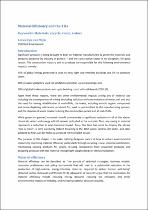JavaScript is disabled for your browser. Some features of this site may not work without it.
- ResearchSpace
- →
- Research Publications/Outputs
- →
- Book Chapters
- →
- View Item
| dc.contributor.author |
Van Wyk, Llewellyn V

|
|
| dc.date.accessioned | 2015-11-20T12:24:48Z | |
| dc.date.available | 2015-11-20T12:24:48Z | |
| dc.date.issued | 2015-08 | |
| dc.identifier.citation | Van Wyk, LV. 2015. Material efficiency and the 3 Rs. In: Green Building Handbook South Africa, Volume 8: the Essential Guide, pp 126-139. | en_US |
| dc.identifier.uri | http://hdl.handle.net/10204/8304 | |
| dc.description | Copyright: 2015 Alive2Green | en_US |
| dc.description.abstract | Significant pressure is being brought to bear on material manufacturers to green the materials and products produced by industry in general – and the construction sector is no exception, for good reason. The construction industry and its products are responsible for the following environmental impacts, namely: a) 45% of global energy generated is used to heat, light and ventilate buildings and 5% to construct them; b) 40% of water globally is used for sanitation and other uses in buildings; and c) 70% of global timber products end up in building construction (Edwards 2002:10). Apart from these impacts, there are other environmental impacts arising out of material use including the consequences of mining (including pollution and contamination of water, soil and air); the need for mining rehabilitation at end-of-life; the toxins, including volatile organic compounds and ozone depleting substances, produced for, used in, and emitted by the manufacturing process; and the disposal of waste products during the construction period and at end-of-life. While green (or greener) materials should demonstrate a significant reduction in all of the above, chemicals, water and energy will still remain embodied in the material. Thus, any saving in material represents a reduction in environmental impact. Truly, the time has come to employ the phrase “less is more”, a term coined by Robert Browning is the 1855 poem ‘Andrea del Sarto’, and later adopted by Mies van der Rohe as a precept for minimalist design. The purpose of this chapter is to make building designers aware of how to reduce environmental impacts by improving material efficiency particularly through recycling, reuse, material substitution, maintaining existing products for longer, re-using components from unwanted products, and designing products with less material through light-weight design or dematerialisation | en_US |
| dc.language.iso | en | en_US |
| dc.publisher | Alive2Green | en_US |
| dc.relation.ispartofseries | Worklist;15471 | |
| dc.subject | Green materials | en_US |
| dc.subject | Building materials | en_US |
| dc.subject | Construction industries | en_US |
| dc.subject | Green buildings | en_US |
| dc.title | Material efficiency and the 3 Rs | en_US |
| dc.type | Book Chapter | en_US |
| dc.identifier.apacitation | Van Wyk, L. V. (2015). Material efficiency and the 3 Rs., <i>Worklist;15471</i> Alive2Green. http://hdl.handle.net/10204/8304 | en_ZA |
| dc.identifier.chicagocitation | Van Wyk, Llewellyn V. "Material efficiency and the 3 Rs" In <i>WORKLIST;15471</i>, n.p.: Alive2Green. 2015. http://hdl.handle.net/10204/8304. | en_ZA |
| dc.identifier.vancouvercitation | Van Wyk LV. Material efficiency and the 3 Rs.. Worklist;15471. [place unknown]: Alive2Green; 2015. [cited yyyy month dd]. http://hdl.handle.net/10204/8304. | en_ZA |
| dc.identifier.ris | TY - Book Chapter AU - Van Wyk, Llewellyn V AB - Significant pressure is being brought to bear on material manufacturers to green the materials and products produced by industry in general – and the construction sector is no exception, for good reason. The construction industry and its products are responsible for the following environmental impacts, namely: a) 45% of global energy generated is used to heat, light and ventilate buildings and 5% to construct them; b) 40% of water globally is used for sanitation and other uses in buildings; and c) 70% of global timber products end up in building construction (Edwards 2002:10). Apart from these impacts, there are other environmental impacts arising out of material use including the consequences of mining (including pollution and contamination of water, soil and air); the need for mining rehabilitation at end-of-life; the toxins, including volatile organic compounds and ozone depleting substances, produced for, used in, and emitted by the manufacturing process; and the disposal of waste products during the construction period and at end-of-life. While green (or greener) materials should demonstrate a significant reduction in all of the above, chemicals, water and energy will still remain embodied in the material. Thus, any saving in material represents a reduction in environmental impact. Truly, the time has come to employ the phrase “less is more”, a term coined by Robert Browning is the 1855 poem ‘Andrea del Sarto’, and later adopted by Mies van der Rohe as a precept for minimalist design. The purpose of this chapter is to make building designers aware of how to reduce environmental impacts by improving material efficiency particularly through recycling, reuse, material substitution, maintaining existing products for longer, re-using components from unwanted products, and designing products with less material through light-weight design or dematerialisation DA - 2015-08 DB - ResearchSpace DP - CSIR KW - Green materials KW - Building materials KW - Construction industries KW - Green buildings LK - https://researchspace.csir.co.za PY - 2015 T1 - Material efficiency and the 3 Rs TI - Material efficiency and the 3 Rs UR - http://hdl.handle.net/10204/8304 ER - | en_ZA |






